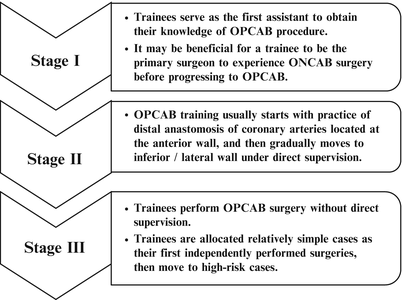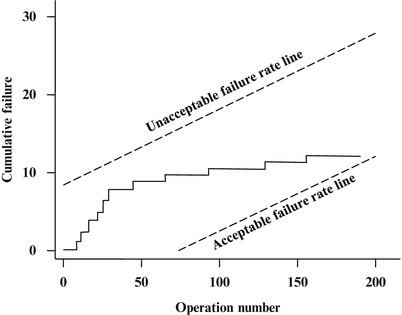Fig. 26.1
Procedural components of OPCAB
26.3.2.1 Exposure (Patient and Heart Positioning)
Trainees should first become familiar with the technique of exposure of the target coronary arteries with simultaneous maintenance of adequate hemodynamics. The operating table can be rotated to facilitate exposure of the lateral/inferior wall of the heart.
26.3.2.2 Stabilization of the Target Vessels
The next important step is learning the techniques for positioning the stabilizer so as to eliminate target vessel movement.
26.3.2.3 Performing Distal Anastomosis on the Beating Heart
This step is further divided into five subcomponents, and the trainee needs to learn the proper sequence of these five steps.
1.
Placement of the coronary snare: An elastic suture is placed for temporal occlusion of the target coronary artery.
2.
Coronary arteriotomy
3.
Insertion of the intracoronary shunt: This step provides a bloodless operative field, increases distal perfusion, and decreases the likelihood of technical errors.
4.
Use of a CO 2 blower: This helps to maintain a bloodless operative field and is usually managed by the assistants.
5.
Sewing of the distal anastomosis
26.3.3 Training in a Gradual Manner
According to previous reports, OPCAB training usually starts with practicing the performance of distal anastomoses of coronary arteries located in the anterior wall of the heart and then gradually progresses to distal anastomoses of coronary arteries located in the inferior/lateral wall. This is in contrast to ONCAB training, in which anastomoses on the entire territory of the heart are simultaneously practiced right from the beginning [5, 9].
Initially, all procedures are performed under direct guidance of the supervising surgeon. The trainees later graduate to independent performance of OPCAB surgery and finally serve as OPCAB surgeons, without any intervention by the supervising surgeon.
At the beginning of the training course, the heart-lung machine can be on standby as a safety measure.
The manner in which trainees graduate through the training program is not only indicated in the learning process of technical skills but also in patient selection. The trainees are usually allocated relatively simple cases when they first independently perform surgeries. Once they gain experience, they may be allocated high-risk cases, such as patients with impaired left ventricular function or unstable hemodynamics. For training, careful patient selection by experienced OPCAB surgeons is essential to ensure patient safety and good outcomes [9].
Trainees also need to learn crisis management. This includes assessment of the hemodynamic condition, correcting hemodynamic instability by discussion with the anesthetist, and conversion to ONCAB if necessary.
26.3.4 Adequate (Required) Training Duration and Extent
Proficiency is often linked to operative experience, although the number of practice cases required is unclear and appears to differ among training systems. In terms of ONCAB procedures, a cardiothoracic resident in the United States requires at least 35 cases for accreditation, while in the United Kingdom, over 100 cases is the norm [3]. However, no formal training curriculum has identified the exact number of procedures and duration of training required for acquisition of the skills needed to perform OPCAB.
The entire training process can be divided into three stages. During the first stage, trainees serve as the first assistant whereby they obtain knowledge of the OPCAB procedure. In the second stage, they practice OPCAB as the primary surgeon under close supervision. The third stage is the period in which the trainees perform OPCAB surgery without supervision (Fig. 26.2).


Fig. 26.2
Graduated training process
As mentioned before, trainees usually start practicing distal anastomoses in the anterior wall of the heart, move to the inferior/lateral wall, and finally perform multivessel anastomoses over the entire territory of the heart. Ricci et al. reported that approximately 15–20 OPCAB operations are generally required before residents can perform complete multivessel myocardial revascularization under supervision [1].
Chen et al. trained two young cardiac surgeons who had no previous coronary surgery experience to be independent OPCAB operators [5]. Their training took 24–28 months. During the first stage, the two trainees served as the first assistant in 300–400 OPCAB procedures. After practicing OPCAB under supervision, the trainees started to perform the procedure independently. Performance analysis showed that the trainees reached the proficiency standard after performing 30 surgeries independently.
At the Bristol Heart Institute in the United Kingdom, the training period lasts 6 years. At the first stage, trainees assist senior surgeons for 40–50 OPCAB procedures. Then they move to the second stage. By the end of the third year, trainees perform 30–40 surgeries as the primary surgeon under direct supervision, and proficiency is obtained after 80–100 OPCAB operations. In the last 2 years of training, as the third stage, the trainees are allowed to perform unsupervised operations [10].
26.3.5 Validation of Proficiency
As described before, the OPCAB procedure is technically demanding, and trainees face a steep learning curve. Although senior surgeons are aware of the importance of training young surgeons, they also have an overriding responsibility toward patient safety and good clinical outcomes.
Recently, statistical techniques are increasingly advocated as a means of ensuring quality control and reproducible outcomes. The control chart is one such statistical technique and has been used as a performance monitoring tool for surgical learning curves. By providing a graphic summary of changes in performance with time, control charts can provide alerts regarding suboptimal performance [8].
Cumulative sum failure analysis is the most basic control chart, and modifications of this tool have been employed in several learning curve studies regarding OPCAB surgery [3, 5, 12]. This chart is obtained by plotting the cumulative sum of a specified outcome or failure on the Y-axis versus the sequence of cases on the X-axis. An increase in the gradient (slope) indicates more frequent failures. Further, acceptable and unacceptable failure rate lines can be calculated and drawn [13]. If the graph of cumulative failure crosses the upper boundary (unacceptable failure rate line), then we conclude that the failure rate is unacceptable. If it crosses the lower boundary (acceptable failure rate line), we conclude that the failure rate is less than or equal to the acceptable rate. When a graph remains between these boundaries, the evidence remains inconclusive, and monitoring should continue (Fig. 26.3). Thus, the control chart can be used not only for retrospective studies but also for prospective monitoring of training. When a trainee’s cumulative curve goes beyond the alert line, the trainee and supervisor need to look into performance-related problems.


Fig. 26.3
Cumulative failure chart. X-axis denotes consecutive cases of operation. Y-axis denotes the cumulative sum of a specified outcome or failure. If the graph of cumulative failure crosses the upper boundary, the performance is concluded to be unacceptable. If it crosses the lower boundary, the performance is considered to be acceptable
A previous study using the control chart method indicated that residents’ curves crossed the acceptable boundary after 100 OPCAB cases [3]. Chen et al. also found that trainees’ curves reached a plateau after 30 OPCAB cases and crossed the acceptable boundary after 80 OPCAB cases [5].
Stay updated, free articles. Join our Telegram channel

Full access? Get Clinical Tree


